Honda Civic Service Manual: Fuel Filter B Element Removal and Installation (R18A9)


Compressed natural gas is flammable and highly explosive. You could be killed
or seriously injured if leaking natural gas is ignited.
Stop the engine, and keep heat, sparks, and flames away.
|
|
1.
|
Raise the vehicle on a lift, and make sure it is securely supported.
|
|
| 2. |
Fuel Pressure - Relieving (Between the engine and the manual shut-off
valve) (Natural Gas Model) |
|
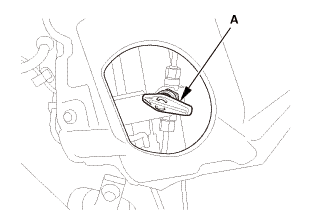
|

Compressed natural gas is flammable and highly explosive. You could be
killed or seriously injured if leaking natural gas is ignited.
Stop the engine, and keep heat, sparks, and flames away.
|
This procedure should be done outside in a well-ventilated area
or in a properly equipped CNG shop.
|
|
This procedure will allow you to safely work on any part of the
fuel system downstream of the manual shut-off valve, such as fuel
pressure regulator P1 or the fuel injectors.
|
|
1.
|
Close the manual shut-off valve (A).
|
|
2.
|
Start the engine, and let it idle.
|
|
3.
|
After a few minutes, the engine will stall.
|
|
4.
|
Turn the ignition switch to LOCK (0).
|
|
|
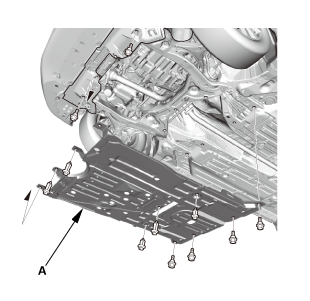
|
|
1.
|
Remove the engine undercover (A).
|
|
| 4. |
Fuel Filter B Element (Natural Gas Model) |
|
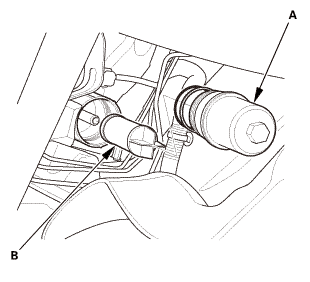
|
|
1.
|
Remove the fuel filter B housing (A), and replace the fuel filter
B element (B).
|
|


Compressed natural gas is flammable and highly explosive. You could be killed
or seriously injured if leaking natural gas is ignited.
Stop the engine, and keep heat, sparks, and flames away.
| 1. |
Fuel Filter B Element (Natural Gas Model) |
|
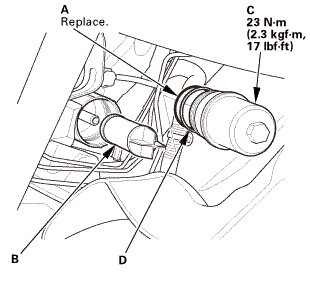
|
|
1.
|
Apply silicone grease (Shinetsu silicone GR 10M) to a new O-ring
(A) and carefully install it into its proper position.
|
|
2.
|
Install the fuel filter B element (B) and the fuel filter B housing
(C).
|
|
NOTE: If the fuel filter B housing is rusty or damaged, replace
the housing and its seal (D).
|
|
|
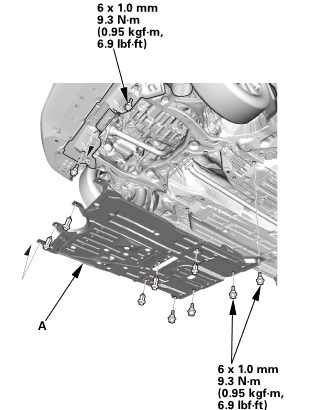
|
|
1.
|
Install the engine undercover (A).
|
|
| 3. |
Manual Shut-off Valve - Open (Natural Gas Model) |
|
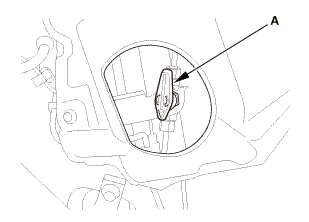
|
|
1.
|
Open the manual shut-off valve (A).
|
|
| 4. |
Fuel Supply System Leak - Inspection (Natural Gas Model) |
|
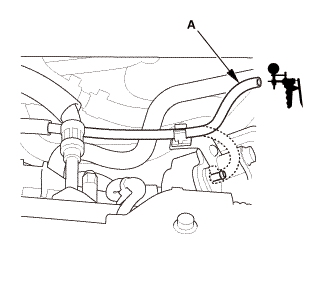
|
|
Check for a gas leak if there is an odor coming from the vehicle.
Compressed natural gas (CNG) can only be smelled, not seen.
|
|
1.
|
Open the hood and the fuel fill door.
|
|
2.
|
Connect a vacuum pump/gauge, 0-30 inHg, to the hose (A) from
fuel pressure regulator P1, and apply 67.7 kPa (20.0 inHg, 508 mmHg)
of vacuum.
|
|
3.
|
If fuel pressure regulator P2 does not hold vacuum, replace it
before continuing to the next step.
|
|
4.
|
Inspect the fuel lines and hoses under the hood for kinks, abrasion,
and other signs of damage.
|
|
5.
|
With the manual shut-off valve open, turn the ignition switch
to ON (II), but do not start the engine.
|
|
6.
|
After the fuel pressure regulator shut-off solenoid valve/fuel
tank internal solenoid valve operates for about 2 seconds, the fuel
pressure in the fuel lines rises.
|
|
7.
|
Turn the ignition switch to LOCK (0).
|
|
8.
|
Repeat this two or three times.
|
|
|
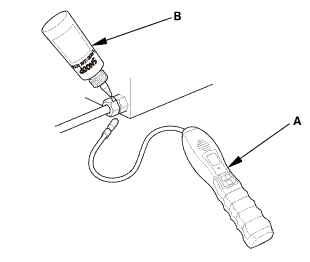
|
|
9.
|
Within 1 minute, check for any damaged lines with a leak detector
(A) (Snap-on Combustible Gas Leak Detector or Snoop Liquid Leak
Detector (B)).
|
|
|
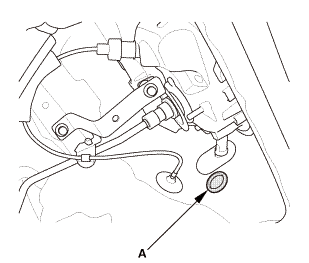
|
|
10.
|
If no damage was noticed during the inspection, turn the ignition
switch to ON (II) for 2 seconds, then turn the ignition switch to
LOCK (0).
|
|
11.
|
Within 1 minute, check for a leak at the vent hose outlet inside
the fuel pipe protector (A).
|
|
12.
|
If you detect a leak, remove the vent hose, and check the fuel
lines and fittings at the in-tank solenoid valve and the join block
with a leak detector.
|
|
13.
|
If you cannot find the leak, raise the vehicle on a lift, remove
the under-floor cover.
|
|
14.
|
Inspect all the fuel lines under the vehicle, visually, and with
a leak detector.
|
|
15.
|
If you still cannot find the leak, remove the rear seat, then
check all fuel lines and fittings at the fuel tank and the fuel
joint block.
|
|
Compressed natural gas is flammable and highly explosive. You could be killed
or seriously injured if leaking natural gas is ignited.
Stop the engine, and keep heat, sparks, and flames away.
...
Inspection
1.
Fuel Line - Inspection
1.
Check the fuel system lines and hoses for damage, leaks, and deterioration.
Replace any damaged parts.
...




 Fuel Filter A Removal and Installation (R18A9)
Fuel Filter A Removal and Installation (R18A9) Fuel Line Inspection (K24Z7)
Fuel Line Inspection (K24Z7)








